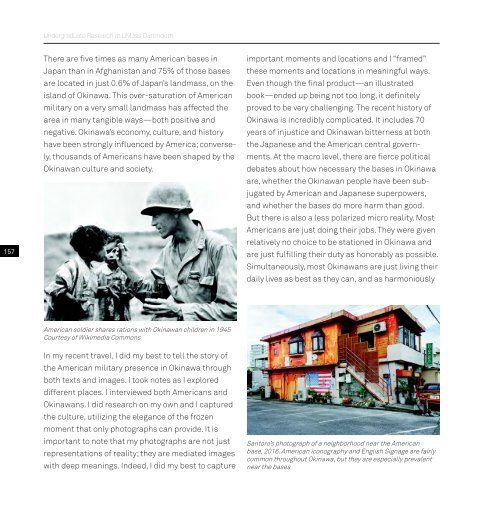Undergrad_Book_16-18_Pge_View_Print_no print marks_compressed
You also want an ePaper? Increase the reach of your titles
YUMPU automatically turns print PDFs into web optimized ePapers that Google loves.
<strong>Undergrad</strong>uate Research at UMass Dartmouth<br />
157<br />
There are five times as many American bases in<br />
Japan than in Afghanistan and 75% of those bases<br />
are located in just 0.6% of Japan’s landmass, on the<br />
island of Okinawa. This over-saturation of American<br />
military on a very small landmass has affected the<br />
area in many tangible ways—both positive and<br />
negative. Okinawa’s eco<strong>no</strong>my, culture, and history<br />
have been strongly influenced by America; conversely,<br />
thousands of Americans have been shaped by the<br />
Okinawan culture and society.<br />
important moments and locations and I “framed”<br />
these moments and locations in meaningful ways.<br />
Even though the final product—an illustrated<br />
book—ended up being <strong>no</strong>t too long, it definitely<br />
proved to be very challenging. The recent history of<br />
Okinawa is incredibly complicated. It includes 70<br />
years of injustice and Okinawan bitterness at both<br />
the Japanese and the American central governments.<br />
At the macro level, there are fierce political<br />
debates about how necessary the bases in Okinawa<br />
are, whether the Okinawan people have been subjugated<br />
by American and Japanese superpowers,<br />
and whether the bases do more harm than good.<br />
But there is also a less polarized micro reality. Most<br />
Americans are just doing their jobs. They were given<br />
relatively <strong>no</strong> choice to be stationed in Okinawa and<br />
are just fulfilling their duty as ho<strong>no</strong>rably as possible.<br />
Simultaneously, most Okinawans are just living their<br />
daily lives as best as they can, and as harmoniously<br />
American soldier shares rations with Okinawan children in 1945<br />
Courtesy of Wikimedia Commons<br />
In my recent travel, I did my best to tell the story of<br />
the American military presence in Okinawa through<br />
both texts and images. I took <strong>no</strong>tes as I explored<br />
different places. I interviewed both Americans and<br />
Okinawans. I did research on my own and I captured<br />
the culture, utilizing the elegance of the frozen<br />
moment that only photographs can provide. It is<br />
important to <strong>no</strong>te that my photographs are <strong>no</strong>t just<br />
representations of reality; they are mediated images<br />
with deep meanings. Indeed, I did my best to capture<br />
Santoro’s photograph of a neighborhood near the American<br />
base, 20<strong>16</strong>. American ico<strong>no</strong>graphy and English Signage are fairly<br />
common throughout Okinawa, but they are especially prevalent<br />
near the bases



